
1954 Mercedes RW196
The first real prototype test of the W196 F1 car was in held in February 1954 and the importance of preparation was now needed more than ever. While pit stops had been an integral part of the pre-war planning through the early 1950s pit stops were becoming less and less frequent, in some cases cars could run the whole GP race distance without stopping at all, other factors were now taking on higher levels of importance and Alfred Neubauer was the master of the seemingly unimportant details that others ignored.
During the tests of the W196 prototype at Hockenheim Neubauer was determining the ultimate fuel tank aiming for a fuel consumption rate of 35Ltrs to cover 1000km. In testing it was found to be 40ltrs and this represented the cars rolling to a stop 48km short of the finishing line. Herr Doctor Engineer Uhlenhaut was despatched back to Stuttgart to oversee the fabrication and positioning/mounting options for additional fuel tanks within the cars.
The W196 F1 design was as cutting edge as it could be in 1954. After two years of running the driver’s world championship to Formula two regulations the new 2.5-litre un-supercharged (or 750cc supercharged) F1 era began and Alfred Neubauer, and Mercedes-Benz, intended that the firms returned to Grand Prix racing would see the new Silver Arrows as superior as they had been in the 1930s.
Uhlenhaut did extensive research into the engine options considering the power range for a competitive engine needed to be 250 to 300bhp (190 to 220 kW). In 1939 Mercedes' 2-stage supercharged 1.5-litre motor gave 278bhp (207kW) at 8,250 rpm. If Mercedes halved that engine they could only expect around 139bhp (104kW). However, the engine development team were able show they could achieve 390bhp @ 10,000rpm from a 0.75 litre supercharged motor if they ran the pressure at 4.4atm, although driving the supercharger stole around 100hp. The real problem was that this configuration drank 2.3 times more fuel than a naturally aspirated engine to develop the same power. Clearly that would require more pit stops, or carrying extra fuel and weight.
Since the 1920s all previous Mercedes-Benz Grand Prix engines had been supercharged so a move towards naturally aspirated engine would be a significant shift in philosophy. But as naturally aspirated motorcycle racing engines of that era could develop 115bhp/l (86kW/l) at 9,000rpm Mercedes engineers decided that the 2.5-litre engine was the correct choice.
Building on the knowledge obtained by the Daimler-Benz engineers who refined the high-performance DB601 V12 engine, used in the Messerschmitt Bf 109E fighter aircraft of WWII, Ulenhaut and his team worked with Bosch engineers to adapt a direct fuel injection system for their new straight 8 engine of 2,496.87cc capacity. Direct fuel injection had worked on the 300sl racing cars and the benefits had been clear to the team. Mercedes-Benz also included the use of desmodromic valves, instead of a cam to open and a spring to return them, the 16 valves were opened and closed by positive action of mechanical linkage operated by four short camshafts. Drive for the valves was taken from the centre point of the engine which was essentially two four cylinder engines put end to end. The short cams and desmodromic linkage allowed the engine to be revved much higher than an engine with conventional long cams as the short ones didn't bend under heavy loads. These innovations gave a considerable advantage over engines that used conventional carburetors.
Furthermore, Mercedes-Benz collaborated with Esso to produce that most advanced fuel technology F1 had ever seen. This fuel, labelled RD1, was an exotic brew of 45% benzol, 25% methyl alcohol, 25% high octane petrol, 3% acetone and 2% nitro-benzine. Ulenhaut's team had aimed for 340bhp (250kW) at 10,000rpm from their engine and at the 1954 French GP their exceptionally advanced engine produced 257bhp @ 8000rpm, they pushed this to 290bhp at 8500 rpm within the year.
If all this wasn't the most technologically advanced F1 design ever Mercedes even experimented with variable length inlet tracts in an effort to maximise the motors drivability in as wide a power band as possible, although this wasn't included in the final production engine.
The cars chassis followed the 300sl idea being a space frame design made up of welded small diameter aluminium tubes, it had light weight and exceptional rigidity. To give a better front/rear weight distribution balance the engine was mounted longitudinally behind the front axles moving it towards a “front mid-engined” layout. In order to reduce the cars frontal area and height the engine was canted over at 37° to the right moving the drive shaft away to the left.
Power was fed through a sub-shaft and a prop-shaft to the five speed gearbox which was built “in unit” with the differential. The use of a five speed gearbox was another innovation that would prove to be a distinct advantage over Mercedes rivals, who generally still used four speed gearboxes.
Braking was achieved through huge extra wide diameter drums which were mounted in board and operated by short half shafts, with two universal joints per wheel, as the drums (equipped with fins for a so-called 'Turbo-cooling' effect), were too big to fit in the 16" wheel rims. This shaft system would also have been preferable if the design team had gone ahead with the idea of four-wheel drive. Other advantages to the system are the reduction in un-sprung weight and moving the weight more centrally to aid balance and handling.
Suspension was by torsion bars fitted inside the chassis tubes with dual wishbones at the front and swing axles at the rear. An anti-roll system was included to help reduce the swing axles from raising the front of the car under cornering forces. This consisted of a system of off-centred rods linking the hub to the opposite side of the chassis crossing one-another over the centre line.
The W196 was plagued by “snap-oversteer” throughout its life but, sparing no expense, Mercedes worked tirelessly to find a solution. This was mostly achieved by varying the wheelbase lengths, and body styles, for specific tracks. In the end there were three wheelbase lengths (92, 87 ½ and finally 85 inches), and two body styles although none these efforts really solved the handling problems they did help in other areas allowing Mercedes to ultimately be successful.
Mercedes continued their theme of ultimate technology usage with the cars bodywork. Use of ultra-light Elektron magnesium-alloy, which has a specific gravity of 1.8, less than a quarter of iron's 7.8, weight was kept to a minimum. Using a 1/5th scale wooden model in the wind tunnel of the Motor Research Institute at Stuttgart Technical College Mercedes created an all-enclosing streamlined body shell which exploited a loophole in the new GP rules. For high speed circuits, this sports car styling proved very effective but at the twisty tracks the drivers found the hidden front wheels hampered their ability to position the car for corners. To counter this a more conventional open wheel body work style was developed.
The opinion that really counted was that of the drivers and later Fangio described the Mercedes RW196 as :-
"… a bit difficult to drive, with a tendency for snap oversteer", and "not so nice to drive as a Maserati 250F, but you were almost sure to finish. So, the Mercedes was incredible in that way."
Moss agreed and was later recorded as saying :-
"I'm surprised that the Merc' wasn't a little bit easier to drive, because it wasn't. It was a driver's car, but not an easy car to drive."
It wasn’t just the new Mercedes cars that were being pushed to the limits of technology, the mechanics had their roles scrutinised too. When the car went past the pits there were mechanics especially assigned to check certain areas of the cars in detail. While one man was checking the front wheels/tyres another was checking the rears, another would be listening to the engine sounds and another to the exhausts, yet another would be observing the driver for his signals. The idea of a team sport was developing more than ever under the direction of Alfred Neubauer.
After a 15 year absence from the Grand Prix scene the Mercedes-Benz return was nothing short of a sensation, the appearance of the Rennabteilung at the circuits was something akin to an "expedition". Huge volumes of equipment and personnel, all under the scrutiny of the organizational mastermind that was Neubauer, meant nothing was left to chance; only Mercedes were likely to be able to magically produce a replacement windscreen should one be shattered by a stone. All this meant the new silver Arrows should once again be as superior as they had been in the 1930s; and nothing less would be acceptable.
Neubauer's driver choices were fairly predictable for the most part. The pre-war favourites were mainly retired but Germans Karl Kling, Hermann Lang and Hans Herrmann were already on staff so there were no surprises there. However, Neubauer scored a coup when he signed 1951 champion Juan Manuel Fangio, although it took some wrangling to capture him.
After all the unceremonious hard graft on the design and production of the car, the cataloguing of the many details of the circuits and the driver negotiations, the time came for the RW196s debut. The 1954 French GP was held on the 5.2 mile (8.3km) temporary road course of Reims Champagne. The XLI Grand Prix de l'ACF would be a sensational event, 40 years and one day after Mercedes had humiliated Peugeot in 1914. This time the competition wasn't from French cars but from the Italian cars of Ferrari and Maserati. The result was the same though, a crushing 1-2 victory for Mercedes-Benz in front of 300,000 fans.
Design engineers Drs. Nallinger and Uhlenhaut were ecstatic, as was Neubauer. All the hard work in all areas had come to fruition in the very first competitive race. At that point in time Mercedes “Rennabteilung” was on top of the world and everyone else was scratching their heads on how to keep up. Then came the VII RAC British GP at Silverstone.
It was immediately obvious that the enclosed wheel bodywork was hampering the drivers. Although Fangio did take pole position, Kling could only manage 6th on the grid; and neither was happy. The race didn’t go well at all with both Kling and Fangio continuing their obsession with hitting the track marker barrels and damaging the front wings of their cars. José Froilán González lead from flag to flag with teammate Mike Hawthorn in the second Ferrari giving the Scuderia Ferrari a 1-2 victory.
Silverstone was a bitter disappointment for the team and Neubauer, in a very poor mood, started the autopsy straight away. The engineers and technicians including the Chief designer and Engineer of the testing department, Drs. Nallinger and Uhlenhaut, all had a part to play in overcoming the issues brought up during the race weekend at Silverstone. As well as the issues with positioning his car Fangio was concerned about the snap-oversteer and handling problems. Equally important was Kling's complaint that the Ferrari engine clearly had better acceleration out of the low speed corners than Mercedes RW196 because it had more torque in the lower rev' range.
Mercedes discovered the streamlined body had more issues than just the lack of visibility of the wheels, on the winding roads of circuits like the Nürburgring this bodywork was unstable and prone to catching the crosswinds. Having spawned the idea of the streamliner during the usual fascinating struggle that the engineers always have imposed upon them by the ever-changing "racing formulas" Mercedes designers found a flaw in their process and now had to undo this grand design plan and come up with a more conventional open wheel body; in a very short space of time.
When the RW196 cars rolled off the transporters for the XVII Großer Preis von Deutschland at the Nürburgring an open wheel car appeared. It looked rather unfinished and “slightly hurried” and, in contrast with the carefully sculpted streamliner bodies, unrefined. Contemporary reporters described the new model as ‘unhandsome’.
The sixth round of the 1954 F1 Drivers' Championship would run over the 14.173 mile (22.810km) Nordschleife of the Nürburgring, a place later called the green hell and generally considered the most complex of circuits. Adding to this worrisome place the race was lengthened from 18 to 22 laps to bring it in line with the usual 500km race distance of the other Grands Prix.
The result was the first home victory for Mercedes in 15 years and Fangio's winning time of 3h45m45.8s made this the longest F1 GP in history. It also set him up for winning the Championship at the next race as he now had more than twice the points of nearest rival José Froilán Gonzalez. Kling claimed fastest lap of 9m55.1s for Mercedes.
Now we come to subject of our model. Karl Kling’s car at the XIV Großer Preis der Schweiz held at the 4.524 mile Bremgarten circuit. This was the seventh round of the driver’s championship and could decide the title outcome if Fangio won. José Froilán González took pole with Fangio beside him so the two title protagonists were set up for the fight.
As the field splashed around on the 22nd of August 1954, Fangio moved into the lead with Moss soon passing González for second place and pushing hard to catch Fangio. But Hawthorn was soon putting pressure on Moss and this pair put on a furious patriotic spectacle as they duelled. This was the real entertainment of the race until Moss' Maserati was stopped by and engine failure with Hawthorn in the Ferrari joining him in retirement with fuel feed problems. Fangio dominated the 66 race lapping everyone up to González in second place and heading him home by over a minute. Hans Herrmann brought his Mercedes home third (which would turn out to be his last podium), but Karl Kling did not finish due to fuel system problems. Fangio's winning time was 3h00m34.5s and he set fastest lap 2m39.7s on lap 34.
Mercedes RW196, chassis number 00006, had carried Fangio to his second drivers title, with two races still to run, and in scoring his twelfth GP win here Fangio regained the record for the most victories from Alberto Ascari. Clearly there was much for Neubauer and the team to celebrate although this would turn out to be the last F1 race to be held in Switzerland as the disastrous 1955 Le Mans crash prompted the Swiss government to ban all forms of motor racing.
Moving on to the XXV Gran Premio d'Italia held at the Autodromo Nazionale Monza and the team looked to further dominate Ferrari and with this in mind Fangio's pole time of 1m59.0s was a good sign on the high speed circuit.
After 80 laps of the 3.915 mile circuit on a that sunny September day Fangio had converted the pole position into a victory. Mike Hawthorn finished second for Ferrari and Umberto Maglioli and José Froilán González had to share a Ferrari to get third place. Fangio's winning time was 2h47m47.9s although González set the fastest lap of 2m00.8s on the second lap of the race. Sadly, the other Mercedes cars finished as they had at Bremgarten, Herman fourth 3 laps down and Kling retiring.
The last GP of the 1954 season was the Spanish GP held on the temporary street circuit of Pedralbes, Barcelona. The sunny Spanish track saw the debut of the eagerly awaited Lancia D50 which Ascari promptly put on pole position with a lap time of 2m18.1s for the 313.966 mile course. The brilliant design used the off-set 90degree V8 engine as part of the chassis (pre-dating the Lotus 49 concept) to give stiffness with weight reductions. In its own way it was as advanced as the Mercedes and had great potential for the future.
The race started well for Lancia but Villoresi retired his D50 on lap one with brake trouble and Ascari's D50 was put out on lap 9 because of a failed clutch. Hawthorn and Fangio battled for the race lead but Fangio's Mercedes was losing oil and slowed him to third place when Luigi Musso hustled his Maserati through into second place. Hawthorn-Musso-Fangio was the order at the finish with the Lancia of D50 having set the fastest race lap of 2m20.4s on lap 3.
The return to F1 had been a great success with Fangio taking the title and the cars recording 5 pole positions, 4 fastest laps and 4 wins from the 6 races they contested. Neubauer's role was evolving as he was reaching the autumn of his career, the races were changing and the chief designers and engineers were taking over aspects of Neubauer's influence. But 'Don Alfredo' remained the driving force behind the team and still defining new areas of racing that should be studied as affecting the cars chances of winning; the result was Mercedes-Benz domination of the Grands Prix races, just as it always was and just as Neubauer and the Daimler-Benz board expected.
More detailed information on Mercedes 1954 season can be found in our biography of the great Mercedes team manager Alfred Neubauer.


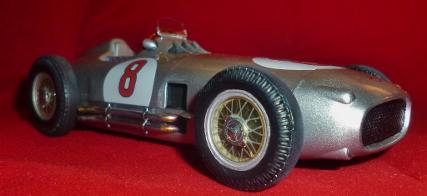

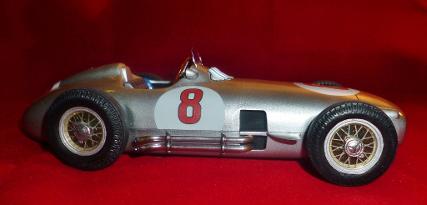


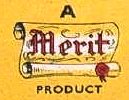


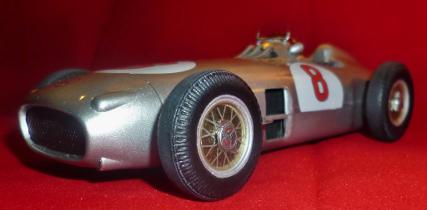

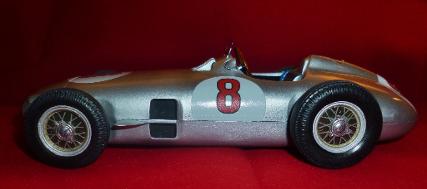



The Merit Mercedes, kit # 4635, was released in the late 1950s, possibly as early as 1956. Although listed as the 1955 Mercedes it doesn’t have the air induction snout of the 1955 cars so more closely resembles the 1954 Mercedes GP car. Fangio’s car had an early version of this air inlet a on his car for all GP except the Swiss GP in 1954, so this race would be the only one you could make a ‘Fangio’ car from the box without conversion work. However, as Fangio’s name was being saved for a 1955 Streamliner Ian thought it better to remember the efforts of Kling, Hermann and Taruffi who are so often overshadowed by Fangio and Moss.
Ian built this model as a straight from the box affair, well as straight from the box as you can when the kit was previously made by someone else, had missing and broken parts and of course no decals. It is a faithful reproduction of the original kit in all aspects except the decals which had to be sourced elsewhere and from the spares box. Some are from a set from Patto’s Place (the Australian slot car man whose decal bank is huge) and others are the excellent Vintage Racing Miniatures Mercedes 300SLR decals set.
The decision to use the original clear discs and spoke decals (saved from a different Merit car kit) was an agonising one, but ultimately the only way to really honour the kit. New axles had to be made as the they were all broken in the kit. Drilling them out and replacing them with plastic rod was the best solution. One of the hub knockoffs was missing but a resin cast replacement was easily made from a moult of the remaining one of the front pair. A whole new wind screen had to be scratch built but was kept to a simple design similar to that of the original kit.
Primers used where from Alclad II and the silver is from PlamoUK. The body was covered with PlamoUK clear but not polished in anyway. This being a conscious effort not to make it to bright. Molotow liquid chrome pens proved very useful, carefully protected with “Klear” floor polish. Mirror glass sets off the mirrors nicely and overall the model looks very presentable.
The model was built in July 2017 and is meant to show how nice these cars can be with the benefit of today’s paints and techniques. As Ian has several more resin bodies made from moulds of this kit more highly detailed Mercedes GP cars of the 1954/55 seasons will be made in the future. Having this model as an original straight from the box build will help the viewing public understand the level of work included in ding a full detail model. Such a pair would make a striking combination.
RETURN TO :-
